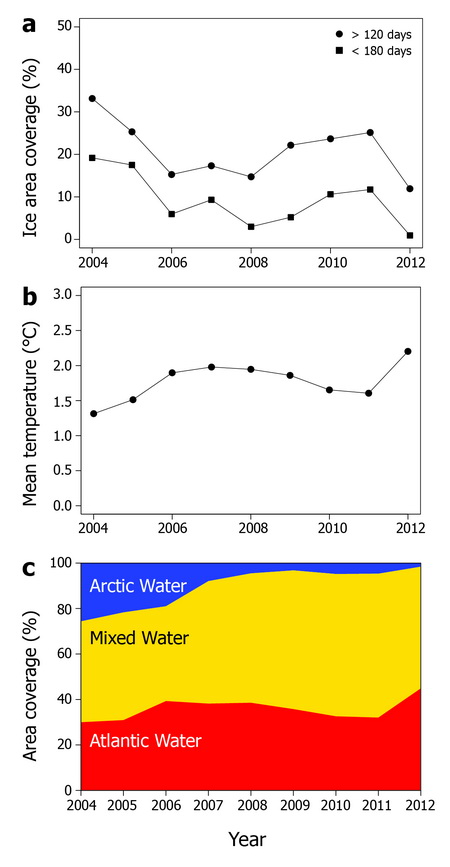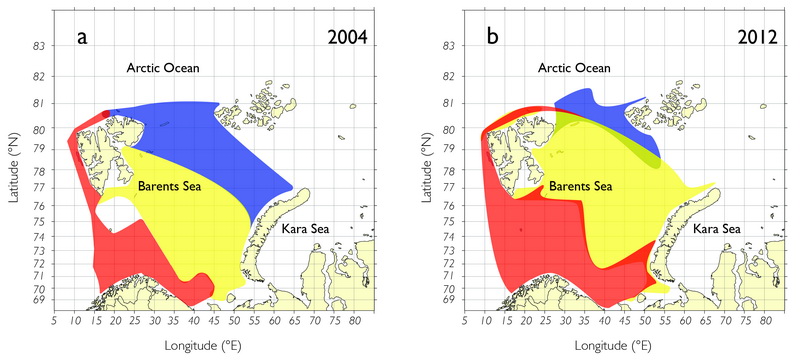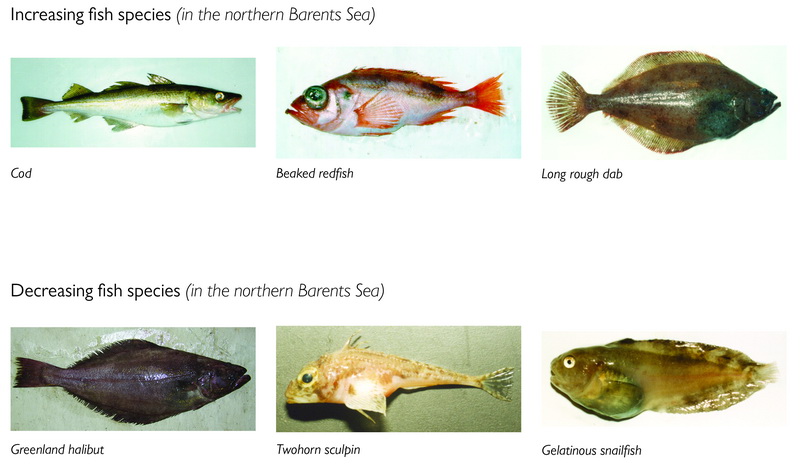M. Fossheim1, R. Primicerio2, E. Johannesen1, R. B. Ingvaldsen1, M. M. Aschan2, A. V. Dolgov3
1Institute of Marine Research, Norway
2UiT, The Arctic University of Norway, Tromsø, Norway
3Knipovich Polar Research Institute of Marine Fisheries and Oceanography, Murmansk, Russia
Introduction
The biological impacts of climate change include shifts in population range and distributions, typically poleward (Doney et al. 2012, IPCC 2014). The pace of shifting populations reflects local climate velocities (Pinsky et al. 2013). In the Arctic, where warming is currently twice the global average (Hoegh-Guldberg and Bruno 2010), major shifts in species distribution are occurring (Cheung et al. 2009, Doney et al. 2012). In the marine environment, shifting species have been entering the Arctic Ocean from both the Atlantic Ocean and the Pacific Ocean (Grebmeier et al. 2010, Wassmann et al. 2011). Boreal (warm-water affinity) species of fish have shifted extensively northward into the Arctic domain (Mueter and Litzow 2008, Grebmeier et al. 2006, Rand and Logerwell 2011, Christiansen et al. 2013, Fossheim et al. 2015).
Here we present the case of the Barents Sea, the entrance point to the Arctic Ocean from the Atlantic Ocean. The results are based on a large-scale annual Ecosystem Survey that monitors the whole ice-free shelf of the Barents Sea in August-September, the season with the least sea ice. This cooperative survey between Russia (Knipovich Polar Research Institute of Marine Fisheries and Oceanography) and Norway (Institute of Marine Research) was initiated in 2004. The focus is on observations for the period 2004-2012, as they have been most thoroughly assessed.
The Barents Sea is Warming
In the sub-arctic Barents Sea, the present warming trend started in the late 1990s, with the temperature at the seafloor in late summer increasing by almost 1°C during the last decade alone (Fig. 10.1b). Sea surface temperature is also increasing (see Fig. 5.1c in the essay on Sea Surface Temperature). In addition, the sea ice in this region is retreating and sub-zero water masses in late summer have almost disappeared (Figs. 10.1a and 10.1c).

Poleward Shift of Fish Communities
In association with the aforementioned warming, boreal (warm-water affinity) fish species, primarily from the southwestern Barents Sea, have entered the northern parts of the Barents Sea in large numbers. The movements of these fish species have led to a shift in communities: boreal communities are now found further north and the local Arctic (cold-water affinity) community has been almost pushed out of the shelf area (Fig. 10.2).


Poleward-moving Fish are Boreal Generalists
Most of the fish species increasing in the north are large boreal fish predators such as cod (Gadus morhua), beaked redfish (Sebastes mentella) and long rough dab (Hippoglossoides platessoides) (Fig. 10.3). This is likely related to improved habitat conditions (both water temperature and food availability) for these fish species in the northern Barents Sea (Fossheim et al. 2015). The northward expansion of the thermal habitat for boreal species, increased productivity in a previously ice-covered area (Dalpadado et al. 2014), and increasing abundance and biomass of Atlantic zooplankton in the northern Barents Sea (Dalpadado et al. 2012), likely favour boreal over arctic fish species.
Cod, the main commercially important species, currently has reached a near record high population size (Table 10.1) not observed since the 1950s due to a combination of a favourable climate and lower fishing pressure (Kjesbu et al. 2014). Recently, high abundances have also been recorded for haddock (Melanogrammus aeglefinus) (Table 10.1), the other main commercial species, and for long rough dab, a very common and widespread species in the Barents Sea. A poleward expansion of cod and haddock, and a north-eastward displacement of beaked redfish (Sebastes mentella) have been suggested (Hollowed et al. 2013, Renaud et al. 2012) and are confirmed by Fossheim et al. (2015).
| TSB 2013 (106 tonnes) |
TSB 2015 (106 tonnes) |
SSB 2013 (106 tonnes) |
SSB 2015 (106 tonnes) |
|
| Cod | 3.590 | 2.963 | 1.943 | 1.139 |
| Haddock | No data | No data | No data | 0.769 |
Consequences for Arctic Fish Species and the Arctic Ecosystem
The Arctic fish community does not seem to cope with rising water temperatures as well as other communities (Fossheim et al. 2015). The Arctic fish community includes species within the families of snailfishes, sculpins and eel pouts (Fig. 10.3). Most arctic fish species are relatively small, stationary and benthivorous (i.e. feeding on benthic organisms living on or in the sediments). A shift in main energy pathways from benthic to pelagic habitats associated with sea ice retreat has been predicted for arctic shallow seas (Wassman et al. 2006, Cochrane et al. 2009), which would have a negative effect on arctic benthivore fish species. As arctic fish species have a more specialized diet (Planque et al. 2014, Kortsch et al. 2015), they are more vulnerable to climate change (Kortsch et al. 2015). In addition, these species are adapted to life on the shallow shelf of the Barents Sea. Since the central Arctic Ocean is much deeper, it is unlikely that these species will move further north. However, they can be found further to the east on the shelf (e.g., Kara Sea).
Large fish and marine mammals can move reasonably quickly over large distances, while other species, such as small arctic fish species and organisms that live on or near the seafloor, are more connected to one place. As a result, two previously separate communities are now mixing together (Fossheim et al. 2015). The larger fish species from the south will compete with the smaller arctic species for food, and even feed directly on these smaller fish species. Thus, the Arctic community is being pressured from two sides; the marine environment is changing as a result of the rising water temperature and new competitors and predators are arriving. It is anticipated that this could result in the local extinction of some arctic fish species, such as the gelatinous snailfish (Liparis fabricii) and even the most abundant arctic species, the Polar cod (Boreogadus saida), from the northern Barents Sea.


As a consequence of the large boreal fish generalists moving north, many novel feeding links are established between incoming and resident species. Consequently, species in the Arctic community become more tightly connected and are no longer clearly separated into distinct food web compartments. In a more connected Arctic food web transfer of energy is faster and benthic and pelagic compartments are more tightly coupled (Kortsch et al. 2015).
References
Cheung, W. W. L., V. W. Y. Lam, J. L. Sarmiento, K. Kearney, R. Watson, and D. Pauly, 2009: Projecting global marine biodiversity impacts under climate change scenarios. Fish. Fisheries, 10, 235-251.
Christiansen, J. S., C. W. Mecklenburg, and O. V. Karamushko, 2013: Arctic marine fishes and fisheries in light of global change. Glob. Change Biol., 20, 352-359.
Cochrane, S. K. J., S. G. Denisenko, P. E. Renaud, C. S. Emblow, W. G. Ambrose Jr., I. H. Ellingsen, and J. Skarðhamar, 2009: Benthic macrofauna and productivity regimes in the Barents Sea – Ecological implications in a changing Arctic. J. Sea Res., 61, 222-233.
Dalpadado, P., R. B. Ingvaldsen, L. C. Stige, B. Bogstad, T. Knutsen, G. Ottersen, and B. Ellertsen, 2012: Climate effects on Barents Sea ecosystem dynamics. ICES J. Mar. Sci., 69, 1303-1316.
Dalpadado, P., K. R. Arrigo, S. S. Hjøllo, F. Rey, R. B. Ingvaldsen, E. Sperfeld, G. L. van Dijken, L. C. Stige, A. Olsen, and G. Ottersen, 2014: Productivity in the Barents Sea – Response to recent climate variability. PLoS ONE, 9, e95273. doi:10.1371/journal.pone.0095273.
Doney, S. C., M. Ruckelshaus, J. E. Duffy, J. P. Barry, F. Chan, C. A. English, H. M. Galindo, J. M. Grebmeier, A. B. Hollowed, N. Knowlton, J. Polovina, N. N. Rabalais, W. J. Sydeman, and L. D. Talley, 2012: Climate change impacts on marine ecosystems. Ann. Rev. Mar. Sci., 4, 11-37.
Fossheim, M., R. Primicerio, E. Johannesen, R. B. Ingvaldsen, M. M. Aschan, and A. V. Dolgov, 2015: Recent warming leads to a rapid borealization of fish communities in the Arctic. Nature Clim. Change, 5, 673-678.
Grebmeier, J. M., J. E. Overland, S. E. Moore, E. V. Farley, E. C. Carmack, L. W. Cooper, K. E. Frey, J. H. Helle, F. A. McLaughlin, and S. L. McNutt, 2006: A major ecosystem shift in the northern Bering Sea. Science, 311, 1461-1464.
Grebmeier, J. M., S. E. Moore, J. E. Overland, K. E. Frey, and R. Gradinger, 2010: Biological response to recent pacific Arctic sea ice retreats. Eos, 91, 161-163.
Hoegh-Guldberg, O., and J. F. Bruno, 2010: The impact of climate change on the world’s marine ecosystems. Science, 328, 1523-1528.
Hollowed, A. B., B. Planque, and H. Loeng, 2013. Potential movement of fish and shellfish stocks from the sub-Arctic to the Arctic Ocean. Fish. Oceanogr. 22, 355-370.
ICES, 12 June 2015: Latest Advice (for cod: Gadus morhua and haddock: Melanogrammus aeglefinus in the Barents Sea ecoregion) [http://www.ices.dk/community/advisory-process/Pages/Latest-advice.aspx].
IPCC, 2014: Summary for policymakers. Climate Change 2014: Impacts, Adaptation, and Vulnerability, Field, C.B. et al., eds., Cambridge University Press, 1-32.
Kjesbu, O. S., B. Bogstad, J. A. Devine, H. Gjøsæter, D. Howell, R. B. Ingvaldsen, R. D. M. Nash, and J. E. Skjæraasen, 2014: Synergies between climate and management for Atlantic cod fisheries at high latitudes. PNAS, 111, 3478-3483.
Kortsch, S., R. Primicerio, M. Fossheim, A. V. Dolgov, and M. Aschan, 2015: Climate change alters the structure of arctic marine food webs due to poleward shifts of boreal generalists. Proc. R. Soc. B, 282, 20151546.
Mueter, F. J., and M. A. Litzow, 2008: Sea ice retreat alters the biogeography of the Bering Sea continental shelf. Ecol. Appl., 18, 309-320.
Pinsky, M. L., B. Worm, M. J. Fogarty, J. L. Sarmiento, and S. A. Levin, 2013: Marine taxa track local climate velocities. Science, 341, 1239-1242.
Planque, B., R. Primicerio, K. Michalsen, M. Aschan, G. Certain, P. Dalpadado, H. Gjøsæter, C. Hansen, E. Johannesen, L. L. Jørgensen, I. Kolsum, S. Kortsch, L. M. Leclerc, L. Omli, M. Skern-Mauritzen, and M. Wiedmann, 2014: Who eats whom in the Barents Sea: a food web topology from plankton to whales. Ecol. Archives E095-124.
Rand, K. M., and E. A. Logerwell, 2011: The first demersal trawl survey of benthic fish and invertebrates in the Beaufort Sea since the late 1970s. Polar Biol., 34, 475-488.
Renaud, P. E., J. Berge, Ø. Varpe, O. J. Lønne, J. Nahrgang, C. Ottesen, and I. Hallanger, 2012: Is the poleward expansion by Atlantic cod and haddock threatening native polar cod, Boreogadus saida? Polar Biol., 35, 401-412.
Wassmann, P., M. Reigstad, T. Haug, B. Rudels, M. L. Carroll, H. Hop, G. W. Gabrielsen, S. Falk-Petersen, S. G. Denisenko, E. Arashkevich, D. Slagstad, and O. Pavlova, 2006: Food webs and carbon flux in the Barents Sea. Prog. Oceanog., 71, 232-287.
Wassmann, P., C. M. Duarte, S. Agusti, and M. K. Sejr, 2011: Footprints of climate change in the Arctic marine ecosystem. Glob. Change Biol., 17, 1235-1249.
December 16, 2015